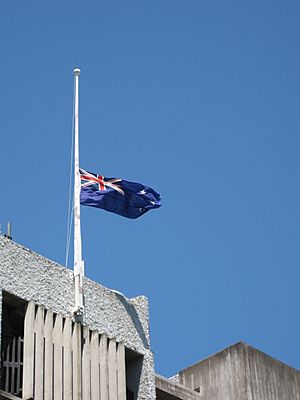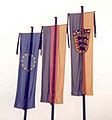Half-staff facts for kids
When a flag is flown at half-staff (or half-mast for ships), it means the flag is not at the very top of its pole. Instead, it is lowered partway down. This is a special way to show respect, sadness, or honor. Many countries use this tradition to remember important people or sad events.
Contents
Why Flags Fly at Half-Staff
Flying a flag at half-staff is a way to show deep respect or sadness. It is often done when an important person has died. It can also happen after a national tragedy, like a natural disaster or a major accident. This tradition helps people come together to mourn or honor someone. It shows that a country or community is feeling sorrow.
How Flags Are Flown at Half-Staff
The flag does not always have to be exactly halfway down the pole. Sometimes, it is flown a little higher or lower than the middle. In some traditions, the flag is placed one flag-width from the top. This leaves space for an "invisible flag of mourning" at the very top. When a flag is raised to half-staff, it is first raised all the way to the top of the pole. Then, it is slowly lowered to the half-staff position. When it is taken down, it is first raised back to the top. After that, it is lowered all the way down.
When Flags Are Flown at Half-Staff Around the World
Many countries have rules about when to fly flags at half-staff. These rules often depend on national holidays, important deaths, or special events.
Examples of Half-Staff Events
- In the United States, flags are flown at half-staff for the death of the President, Vice President, or other important government officials. They are also lowered on certain days, like Memorial Day.
- In the United Kingdom, the Union Flag is flown at half-mast for royal deaths or national tragedies.
- In Canada, flags are lowered for similar reasons, such as the death of a monarch or a former prime minister.
- Some countries, like Saudi Arabia, never fly their national flag at half-mast. This is because their flag includes a religious phrase.
Images for kids
-
The Finnish flag flying at half-mast after the 2011 Norway attacks
-
The American flag flying at half-mast in Buchenwald, Thuringia, Germany, on 19 April 1945 after the death of US President Franklin Roosevelt
-
The Australian White Ensign flying at half-mast. In accordance with British tradition, the flag is flying only one flag's width below the top of the pole.
-
The flag of Canada at half-mast, following the death of Prince Philip, Duke of Edinburgh, 2021
-
Flags in Israel at half mast on the eve of Yom HaShoah
-
Flag of Pahang is flown at half-mast at the Chin Swee Caves Temple as a mark of respect to the late Sultan Ahmad Shah of Pahang. The flag of Malaysia and Selangor are not at half-mast as a result of different mourning periods.
-
Flag at half-mast in Żebbuġ, Malta for Good Friday 2014
-
Two flags half-mast at the Martinitoren in Groningen, Netherlands
-
Flags of Singapore outside The Fullerton Hotel Singapore are flown at half-mast to mark the death of Lee Kuan Yew.
-
ROC(Taiwan) national flag flown half mast at the Presidential Office Building
-
Thai national flag flown at half mast at Assumption College (Thailand) Bangkok during the mourning of the King Bhumibol
-
Turkish flags at half mast after the 2016 Atatürk Airport attack
-
Oratory Church of St Aloysius Gonzaga, Oxford, with the flag of the Holy See flying at half-mast the day after the death of Pope John Paul II
-
The Union Flag flying at half-mast, following the death of Prince Philip, Duke of Edinburgh, 2021
-
The flag at the Capitol Building flies at half-staff in honor of President Ronald Reagan, 2004
See also
 In Spanish: Media asta para niños
In Spanish: Media asta para niños





















